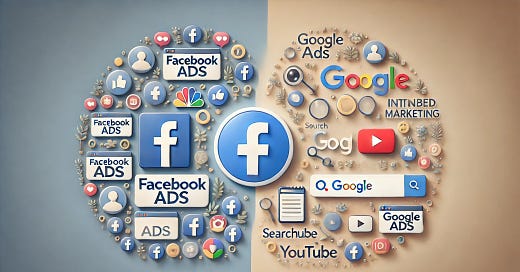If you’re wondering whether to use Facebook Ads or Google Ads for your coaching business, you’re not alone. It’s a common question that every business owner faces when planning their marketing strategy. Both platforms offer powerful ways to connect with potential clients, but which one should you choose?
In this article, I’ll break down the strengths, challenges, and specific use cases of each platform so you can decide which fits your goals.
1. The Basics of Facebook Ads: Simplicity Meets Reach
Facebook Ads (now part of Meta Ads) are widely popular for a reason—they’re simple to use and effective at reaching a broad audience. They allow you to advertise on Facebook, Instagram, Messenger, and even WhatsApp.
Why Facebook Ads Work
Beginner-Friendly: Facebook Ads Manager is easier to navigate than Google Ads. Even if you’re new to advertising, you can set up a campaign relatively quickly.
Broad Reach: With billions of users on Facebook and Instagram, you can target a massive audience.
Versatile Formats: From image ads to carousels to videos, Facebook lets you experiment with different ad formats.
Direct Interaction: You can drive leads directly to WhatsApp or Messenger, making communication seamless.
Challenges with Facebook Ads
High Competition: Since Facebook Ads are so popular, you’re often competing with other businesses in your niche. This means higher costs and the need to stand out with creative ads.
Lower Intent: People scrolling through social media aren’t always looking to buy. You’re interrupting their experience, so you need compelling creatives to grab their attention.
Best Use Case
Facebook Ads are great for beginners who want to generate leads quickly and test their offers. They’re ideal if your audience is active on Instagram or Facebook and you want to build brand awareness or drive webinar sign-ups.
2. Google Ads: The Power of Search Intent
Google Ads operate in a completely different way. While Facebook Ads focus on interrupting a user’s scroll, Google Ads target people actively searching for solutions.
Why Google Ads Work
Search Intent: Google is the world’s largest search engine, and its users are already looking for what you offer. This makes the leads you get from Google Ads highly qualified.
Versatile Formats: Google offers search ads, YouTube ads, and display ads, allowing you to target users at different stages of the buying journey.
High-Quality Audience: YouTube, part of Google’s ecosystem, is the second-largest search engine. Ads on YouTube often reach a more engaged audience.
Challenges with Google Ads
Learning Curve: Google Ads are more complex than Facebook Ads. You’ll need to understand keywords, bidding strategies, and ad formats.
Higher Initial Investment: While Google Ads can yield high-quality leads, the cost per lead is often higher than Facebook Ads.
Best Use Case
Google Ads are perfect for businesses in niches where people actively search for solutions (e.g., SEO services or high-end coaching). They’re also excellent for scaling once you’ve validated your offer.
3. Facebook Ads vs. Google Ads: A Side-by-Side Comparison
Let’s look at the key differences between the two platforms:
4. My Recommendation for Beginners
If you’re just starting out and have a limited budget, I recommend beginning with Facebook Ads. Here’s why:
Ease of Setup: You don’t need extensive experience to run effective Facebook campaigns.
Lower Budget Friendly: Facebook Ads allow you to generate leads with a smaller budget.
Faster Results: Since Facebook targets a broad audience, you can quickly see what works and refine your campaigns.
However, keep in mind that competition is high. To stand out, focus on creating unique ad creatives and writing compelling copy.
5. Scaling with Google Ads
Once you’ve validated your offer and are generating leads consistently, it’s time to expand to Google Ads, especially YouTube Ads.
Why YouTube Ads Stand Out
Engaged Audience: YouTube users are accustomed to watching longer videos, making them more likely to engage with your message.
Targeted Reach: With video discovery ads, you can promote your content to users searching for related topics, helping you grow your audience.
Pro Tip: Start with one of your top-performing organic YouTube videos. Promote it as a discovery ad to boost views and grow your channel faster.
6. Choosing the Right Ad Platform for Your Business
Here’s a quick guide to help you decide:
If You’re a Beginner:
Start with Facebook Ads to test your offer and generate leads quickly.
Focus on webinars, lead magnets, or low-ticket offers to build trust with your audience.
If You’re Scaling:
Transition to Google Ads, particularly YouTube Ads, for higher-quality traffic.
Use search ads if your audience is actively searching for solutions.
If You’re SEO-Dependent:
Focus on Google Ads, as they work well for brands that rely on search traffic.
7. Additional Tips for Success
1. Master One Platform at a Time
Don’t try to juggle Facebook and Google Ads simultaneously. Start with one, refine your strategy, and then expand.
2. Prepare Your Funnel
Before running ads, ensure your landing page, offer, and conversion tracking are ready. A smooth funnel is key to turning ad clicks into conversions.
3. Test Creatives and Copy
Whether you’re using Facebook or Google Ads, experiment with different creatives and messaging. Test what resonates most with your audience.
4. Focus on Metrics that Matter
For Facebook, monitor click-through rates and cost per lead. For Google, track search intent keywords and conversion rates.
Final Thoughts: Start Simple, Scale Smart
Choosing between Facebook Ads and Google Ads isn’t about which is “better.” It’s about which platform aligns with your goals, budget, and audience.
Start simple:
Begin with Facebook Ads to build momentum.
Move to Google Ads when you’re ready to scale or if your niche relies on search traffic.
Remember, the key is to start, learn, and refine as you go. Don’t overthink—just take that first step and let the data guide your next move.
Have questions or need help getting started? Drop your thoughts in the comments, and let’s create a strategy that works for you!













Share this post